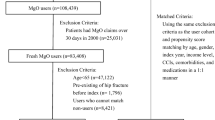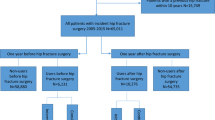Abstract
Summary
Association between warfarin use and fracture risk is unclear. We examined the association between long-term warfarin use and fracture risk at the hip, spine, and wrist in elders. No significant association was found between long-term warfarin use and fracture risk, despite biological plausibility.
Introduction
Prior studies examining the association of warfarin use and osteoporotic fractures have been conflicting, potentially related to methodological limitations. Thus, we examined the association of long-term warfarin use with risk of hip, spine, and wrist fractures among older adults with atrial fibrillation, attempting to address prior methodologic challenges.
Methods
We included men and women ≥65 years of age with incident atrial fibrillation and without prior history of fractures from The Health Improvement Network followed between 2000 and 2010. Long-term warfarin use was defined in two ways: (1) warfarin use ≥1 year; (2) warfarin use ≥3 years. Propensity-score matched cohorts of warfarin users and nonusers were created to evaluate the association between long-term warfarin use and risk of hip, spine, and wrist fractures separately as well as combined, using Cox-proportional hazards regression models.
Results
Among >20,000 participants with incident atrial fibrillation, the hazard ratios (HR) for hip fracture with warfarin use ≥1 and ≥3 years, respectively, were 1.08 (95%CI 0.87, 1.35) and 1.13 (95 % CI 0.84, 1.50). Similarly, no significant associations were observed between long-term warfarin use and risk of spine or wrist fracture. When risk of any fracture was assessed with warfarin use, no association was found [HR for warfarin use ≥1 year 0.92 (95%CI 0.77, 1.10); HR for warfarin use ≥3 years 1.12 (95%CI 0.88, 1.43)].
Conclusions
Long-term warfarin use among elders with atrial fibrillation was not associated with increased risk of osteoporotic fractures and therefore does not appear to necessitate additional surveillance or prophylaxis.



Similar content being viewed by others
References
Rubinacci A (2009) Expanding the functional spectrum of vitamin K in bone. Focus on: “Vitamin K promotes mineralization, osteoblast to osteocyte transition, and an anti-catabolic phenotype by {gamma}-carboxylation-dependent and-independent mechanisms”. Am J Physiol Cell Physiol 297:C1336–C1338
Price PA (1989) Gla-containing proteins of bone. Connect Tissue Res 21:51–57, discussion 7–60
Price PA (1985) Vitamin K-dependent formation of bone Gla protein (osteocalcin) and its function. Vitam Horm 42:65–108
Furie B, Bouchard BA, Furie BC (1999) Vitamin K-dependent biosynthesis of gamma-carboxyglutamic acid. Blood 93:1798–1808
Booth SL, Broe KE, Gagnon DR et al (2003) Vitamin K intake and bone mineral density in women and men. Am J Clin Nutr 77:512–516
Kanai T, Takagi T, Masuhiro K, Nakamura M, Iwata M, Saji F (1997) Serum vitamin K level and bone mineral density in post-menopausal women. Int J Gynaecol Obstet 56:25–30
Feskanich D, Weber P, Willett WC, Rockett H, Booth SL, Colditz GA (1999) Vitamin K intake and hip fractures in women: a prospective study. Am J Clin Nutr 69:74–79
Hodges SJ, Akesson K, Vergnaud P, Obrant K, Delmas PD (1993) Circulating levels of vitamins K1 and K2 decreased in elderly women with hip fracture. J Bone Miner Res 8:1241–1245
Gundberg CM, Lian JB, Booth SL (2012) Vitamin K-dependent carboxylation of osteocalcin: friend or foe? Adv Nutr 3:149–157
Szulc P, Chapuy MC, Meunier PJ, Delmas PD (1996) Serum undercarboxylated osteocalcin is a marker of the risk of hip fracture: a three year follow-up study. Bone 18:487–488
Luukinen H, Herala M, Koski K, Honkanen R, Laippala P, Kivela SL (2000) Fracture risk associated with a fall according to type of fall among the elderly. Osteoporos Int 11:631–634
Knapen MH, Hamulyak K, Vermeer C (1989) The effect of vitamin K supplementation on circulating osteocalcin (bone Gla protein) and urinary calcium excretion. Ann Intern Med 111:1001–1005
Haffa A, Krueger D, Bruner J et al (2000) Diet- or warfarin-induced vitamin K insufficiency elevates circulating undercarboxylated osteocalcin without altering skeletal status in growing female rats. J Bone Miner Res 15:872–878
Whitlon DS, Sadowski JA, Suttie JW (1978) Mechanism of coumarin action: significance of vitamin K epoxide reductase inhibition. Biochemistry 17:1371–1377
Jamal SA, Browner WS, Bauer DC, Cummings SR (1998) Warfarin use and risk for osteoporosis in elderly women. Study of Osteoporotic Fractures Research Group. Ann Intern Med 128:829–832
Caraballo PJ, Heit JA, Atkinson EJ et al (1999) Long-term use of oral anticoagulants and the risk of fracture. Arch Intern Med 159:1750–1756
Mamdani M, Upshur RE, Anderson G, Bartle BR, Laupacis A (2003) Warfarin therapy and risk of hip fracture among elderly patients. Pharmacotherapy 23:1–4
Pilon D, Castilloux AM, Dorais M, LeLorier J (2004) Oral anticoagulants and the risk of osteoporotic fractures among elderly. Pharmacoepidemiol Drug Saf 13:289–294
Gage BF, Birman-Deych E, Radford MJ, Nilasena DS, Binder EF (2006) Risk of osteoporotic fracture in elderly patients taking warfarin: results from the National Registry of Atrial Fibrillation 2. Arch Intern Med 166:241–246
Woo C, Chang LL, Ewing SK, Bauer DC (2008) Single-point assessment of warfarin use and risk of osteoporosis in elderly men. J Am Geriatr Soc 56:1171–1176
Eastell R (2006) Nat Clin Pract Endocrinol Metab 2:484–485
Sato Y, Honda Y, Jun I (2010) Long-term oral anticoagulation therapy and the risk of hip fracture in patients with previous hemispheric infarction and nonrheumatic atrial fibrillation. Cerebrovasc Dis 29:73–78
Rejnmark L, Vestergaard P, Mosekilde L (2007) Fracture risk in users of oral anticoagulants: a nationwide case–control study. Int J Cardiol 118:338–344
Danaei G, Tavakkoli M, Hernan MA (2012) Bias in observational studies of prevalent users: lessons for comparative effectiveness research from a meta-analysis of statins. Am J Epidemiol 175:250–262
AGS Clinical Practices Committee. American Geriatric Society (2000) The use of oral anticoagulants (warfarin) in older people. J Am Geriatr Soc 48:224–227
Bourke A, Dattani H, Robinson M (2004) Feasibility study and methodology to create a quality-evaluated database of primary care data. Inform Prim Care 12:171–177
D’Agostino R Jr (1998) Tutorial in biostatistics: propensity score methods for bias reduction in the comparison of a treatment to a non-randomized control group. Stat Med 17:2265–2281
Seeger JD, Williams PL, Walker AM (2005) An application of propensity score matching using claims data. Pharmacoepidemiol Drug Saf 14:465–476
Soriano L (2011) A UK primary care study on acid-suppressive drugs and hip fracture: is there a link? Gut 60:A36
Yang YX, Lewis JD, Epstein S, Metz DC (2006) Long-term proton pump inhibitor therapy and risk of hip fracture. JAMA 296:2947–2953
Vestergaard P, Rejnmark L, Mosekilde L (2006) Proton pump inhibitors, histamine H2 receptor antagonists, and other antacid medications and the risk of fracture. Calcif Tissue Int 79:76–83
Targownik L, Lix L, Metge C, Prior H, Leung S, Leslie W (2008) Use of proton pump inhibitors and risk of osteoporosis-related fractures. CMAJ 179:319–326
Brown DL, Morgenstern LB, Majersik JJ, Kleerekoper M, Lisabeth LD (2008) Risk of fractures after stroke. Cerebrovasc Dis 25:95–99
Kanis J, Oden A, Johnell O (2001) Acute and long-term increase in fracture risk after hospitalization for stroke. Stroke 32:702–706
Conflicts of interest
Dr. Kiel received grant support from Amgen, Eli Lilly, and Merck Sharp & Dohme, and serves on scientific advisory boards for Amgen, Eli Lilly, Merck Sharp and Dohme, Novartis, and Ammonett Pharma. All other authors state that they have no conflicts of interest.
Support
D. Misra is supported by the Arthritis Foundation Postdoctoral Fellowship Award and Rheumatology Research Foundation Investigator Award. T. Neogi is supported by NIAMS K23 AR055127 and 1R01AR062506-01A1. This work was also supported by NIH P60AR047785-11-6150. Dr. Kiel is supported by a grant from NIAMS R01 AR/AG 41398.
Author information
Authors and Affiliations
Corresponding author
Electronic supplementary material
Below is the link to the electronic supplementary material.
ESM 1
(DOCX 102 kb)
Rights and permissions
About this article
Cite this article
Misra, D., Zhang, Y., Peloquin, C. et al. Incident long-term warfarin use and risk of osteoporotic fractures: propensity-score matched cohort of elders with new onset atrial fibrillation. Osteoporos Int 25, 1677–1684 (2014). https://doi.org/10.1007/s00198-014-2662-0
Received:
Accepted:
Published:
Issue Date:
DOI: https://doi.org/10.1007/s00198-014-2662-0




